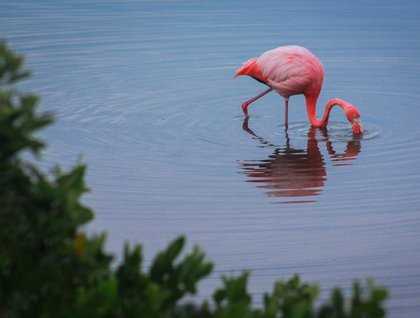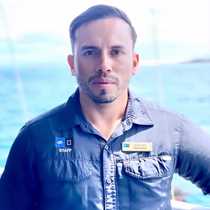Floreana was named after the first Ecuadorian President, known as Juan Jose Flores. This is one of the islands that represent a great piece of the human history of the Galapagos. Charles Darwin himself visited this island in 1835. But before Darwin’s visit, in much earlier years, many buccaneers used the island as a place to get provisions and supplies like giant tortoises and fresh water.
We had a pre-breakfast outing, to visit Cormorant Point. After a wet landing, we walked further into the island, encountering a brackish water lagoon with a large group of greater flamingos. These pink birds are rare within the islands, but since it has been raining, we were lucky to spot around 20 of them feeding on the crustaceans living in the muddy lagoon.
Soon after breakfast, we had a Zodiac ride along the coast of Champion Islet, in search of the Floreana mockingbird. We were lucky to find several of these rare birds, flying over the candelabra cacti. We also spotted several swallow tailed gulls and blue footed boobies. After the ride, we got ready for snorkeling and we jumped in the water to enjoy excellent time with the playful Galapagos sea lions and a large variety of fish among the rocky reefs.
After lunch, we sailed again in order to visit Post Office Bay, where we disembarked to visit the old barrel that served as the oldest mailing system in the Americas. We followed this ancient tradition and dropped postcards in the barrel and picked up some. In the distance are the remains of the house of Eloise von de Bousquet (the baroness of Galapagos), which brought us the memories of the first settlers and their incredible adventures.
We soon started our kayaking outing along the coast of Floreana and enjoyed the sightings of small baby sea lions, great blue herons, sea turtles and a few small black tip reef sharks in the shallow waters.
Just before the sunset we enjoyed the scenery, paddling our kayaks back to the National Geographic Islander.







